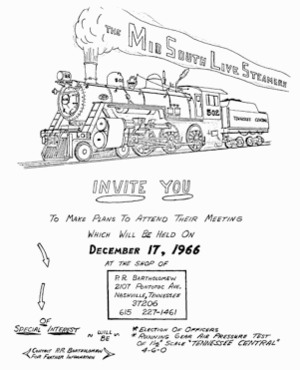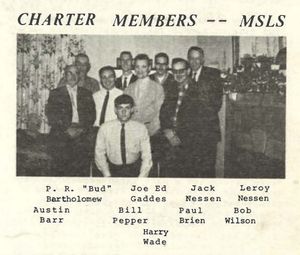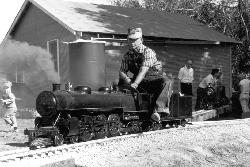Mid-South Live Steamers
History
By Brent Gaddes
Go back in time, if you will, to the mid 1960's. Things were a little different back then, especially in the world of large scale model railroading. There were but a few suppliers of equipment, and most of them provided only rough castings that could be used as a starting point for a live steamer. Large scale model railroading remained almost exclusively the realm of experienced machinists capable of building practically anything from scratch. The wide selection of ready-to-run locomotives and rolling stock that we enjoy today simply was not available.
There were a few live steam clubs scattered around the country, but in middle Tennessee, there was no 7½" gauge track available for operation. In fact, there was no live steam club like the Mid-South Live Steamers in the area at all.
Interest in operating steam locomotives, however, was strong. Diesel locomotives had only recently sent the last remaining steam locomotives to the scrap yards, and many people had vivid memories of the special mystic that can only be found around an operating steam locomotive. Against such a backdrop, the Mid-South Live Steamers was formed.
Early Beginnings
Our story begins much earlier, how-ever. Back in 1955, there was at least one large scale outdoor railroad in operation in Nashville. Although he was only sixteen, Joe Ed Gaddes had built a 400 foot long 8½" gauge outdoor railroad using wooden rails and a home built locomotive powered by a 1½ horsepower Clinton gas engine. Everything was built from scratch, right down to wheels that were cast from aluminum using an iron skillet as a melting pot.
That very same year, a somewhat older gentleman by the name of R. F. "Bob" Wilson began work on an 1.6" scale model of one of the Illinois Central's finest dual-purpose 4-8-2 steam locomotives, number 2614. Bob was a master machinist who lived in Memphis, Tennessee, and had worked at the IC Nonconnah Yard Shops during World War II. Railroad-related activities were a favorite pastime in the Wilson house-hold, and there were plenty of opportunities to catch Frisco, IC, and Mo-Pac trains in action around Memphis. Even around the house, trains were unavoidable. Bob's son, Bob Jr., remembers one rather unusual aspect about his father's locomotive construction: much of the original work on the locomotive was done in his father's bedroom! Bob re-calls stepping around the frame to kiss his parents goodnight.

Meanwhile, Leroy Nessen had been busy pursuing the railroad hobby in various forms. Born in 1910 in Pueblo, Colorado, Leroy had been a railfan for most of his life. He had built an elaborate Lionel layout and then a HO layout complete with a crosstie factory that really split scale ties.
In 1960, a live steam catalog inspired Joe Ed Gaddes to move into live steam, and he began building a 0-4-0 in 1964 while living in Decatur, Alabama. About a year later, in 1965 over in Whitehall, Arkansas, a gentleman named Austin Barr began constructing locomotive #6568, an 1½" scale Pacific.
In 1965, Leroy Nessen learned that Joe Ed was building a live steamer and he began "stirring the pot," looking for other live steamers. As Secretary of the Central Tennessee Model Railroad Association, an HO and O gauge organization, Leroy wrote several letters and made contact with Austin Barr and P. R. "Bud" Bartholomew, who lived in Nashville as did Leroy. Bud Bartholomew had gained experience with steam in the Merchant Marine during World War II. He later became a truck driver and was a skilled, self taught machinist.
In mid-1965, Bud and Leroy visited Joe Ed in Decatur, Alabama. The sight of Joe Ed's 0-4-0 chassis helped motivate Bud to begin work on his first locomotive, a ten wheeler modeled after the Tennessee Central's #502.
On April 20, 1965, Leroy sent out a letter to members of the Central Tennessee Model Railroad Association suggesting that the club change its focus to live stream. The letter suggested that once a sufficiently large membership had been built up, a suitable strip of land would be purchased for installation of a track.
Over the next several months, the various live steamers had a couple of get-togethers and made contact with others interested in the hobby. Among these were Paul Brien and Harry Wade, both of who lived in Nashville. Paul had learned of the group of live steamers from Roy Stewart, a fellow member of the Nashville Model "A" club. Paul had considerable experience in precision metalworking from his job at the Fred D. Wright Company.
Harry Wade, who was the youngest of the group, recalls that his first exposure to a live steamer was at age eight or nine in the mid-1950's when he saw a model of a large engine in an old Mechanics Illustrated magazine. The builder, according to the caption, had spent over ten years and $25,000 building the locomotive. Harry busied him-self with model trains over the next ten years until he was eighteen, when his curiosity finally reached the point where he wanted to know if there was any live steam activity in the Nashville area. A neighbor gave him the name of a person who must have been one of the first persons to build a live steam locomotive in Nashville.
Harry enthusiastically hopped on his motor scooter and headed for the man's house. After introducing himself, Harry quickly discovered that man was not particularly impressed or distracted by his young visitor, but he did finally invite Harry into his basement shop. Harry describes entering a "cave of mechanical wonders", filled with tools, machines, stationary engines, and a ¾" scale Hudson, even then some twenty or so years old.
All too soon, the tour ended. Out-side, the man asked Harry if he had any tools. Harry replied that he had some hand tools - files, a hacksaw, hand drill, wrenches. In no uncertain terms, the man proceeded to inform Harry that there was no way that he could ever build a steam engine without a shop full of expensive machine tools. A stunned Harry retreated with his tail between his legs. Fortunately, though, he soon met others who were more receptive and would go on to help form the Mid-South Live Steamers.
A Club Forms
The stage was set for the formal be-ginning of the Mid-South Live Steamers. A notice was sent out and nine charter members converged on Bud Bartholomew's residence in Nashville on December 17, 1966. In addition to those from Alabama, Arkansas, and Tennessee, Bill Pepper from Andrews, Indiana, made the trip to be at the first meeting. Bill had recently met Bud Bartholomew up in Canada at the Sunparlor Live Steamers, and graciously consented to come to the organizational meeting to give his support and advice. Bill brought with him three hours of films on rail-roads in operation in various parts of the country that were enjoyed by all.
Present at the organizational meeting were Austin Barr, Bud Bartholomew, Bill Pepper, Joe Ed Gaddes, Harry Wade, Paul Brien, Leroy Nessen, Bob Wilson, and Jack Nessen. Jack Nessen, like his father Leroy, was an avid railfan and had helped his father build their impressive HO scale layout, the Bethesda Southern. He was studying transportation at the University of Tennessee in Knoxville at the time.
At the meeting, club officers were elected, dues were set, and suggestions for stationary and letterhead were presented by Austin Barr. It was decided to let Harry Wade design the club logo, which he did. Southern Steam was selected as the name of the newsletter and Leroy Nessen agreed to serve as editor. Several members brought projects in work. Paul Brien brought a heat engine and English locomotive chassis that he had built, and Harry Wade displayed a truck for a Heisler locomotive.
As advertised on the meeting notice, Bud Bartholomew had the chassis for his 4-6-0 running on air and ready for the boiler. Bud would test the engine by tying down the frame, oiling the drivers, and letting them spin in place on a short section of track. (Paul Brien said that this caused problems later. The porous cast iron drivers had soaked up plenty of oil on those test runs. Consequently, when the engine was first run at Austin Barr's track some time later, it would hardly pull itself around the track with-out considerable slipping! Eventually the oil dried out and the locomotive, now owned by Bill Bryan in Georgia, was a dependable performer.)
Operational Meetings
By the time the first edition of Southern Steam came out in March of 1967, Joe Ed had moved to Brentwood, Tennessee, where he was planning a backyard railroad on his one acre lot. Mr. Herman Buettner, down in Cullman, Alabama, had installed a track on his wooded but hilly lot and had fired up his wood-fired Pacific several times. Mr. Buettner had served as an early inspiration to several in the club and had one of the first operating 1½" scale locomotives in the area. In September of 1967, the MSLS held their first operational meeting at Mr. Buettner's track. His railroad included an impressive 12 foot high trestle.
Paul Brien had begun work on an 0-6-0 switcher. Since both he and Bud Bartholomew needed boilers, they had material cut and two identical steel boilers were welded at the same time, one for Paul's engine and the other for Bud's ten wheeler.
The first annual Spring Meet was held in April of 1968 at Austin Barr's recently completed track in on his rice farm in Whitehall, Arkansas. Austin had his Pacific under steam, and was joined by Bud Bartholomew with his recently completed 4-6-0. Leo Myers from St. Louis steamed his 4-2-4 "C. P. Huntington" and Bob Wilson brought over the chassis and smokebox of his big Mountain.
By the Fall of 1968, Joe Ed had completed a 500+ foot loop of track in his backyard with the help of other local MSLS members. Joe Ed recalls how Leroy Nessen, though several years senior to most, put everyone else to shame when it came to shoveling ballast. The track was laid using scale rail, spikes, fish plates, and even tie plates on the cresoted ties. Joe Ed's track was the site of the first MSLS Fall Meet. Present were Bud Bartholomew's 4-6-0, Lynn Lowe's 0-6-0, Austin Barr's 4-6-2, and Leo Myers' "C. P. Huntington".
Austin continued to host Spring Meets for six straight years, and Joe Ed hosted the Fall Meet through 1970. Club membership grew, but only slowly at first. It took four years to double the initial membership, but then momentum began to build and membership doubled again in 1971. In the fall of 1972, the name of the organization was changed from the Mid South Live Steamers Club to the Mid South Live Steamers, Incorporated. By 1973, membership had grown to 53.
The Club Track
The initial club track installation at the Maury County Park in Columbia required an intensive effort to lay almost a mile of track in about one year. The original "high" bridge on the lower loop was made of wood (above, left). Fred Parham deepens the cut for the upper loop with a large front end loader as David Irvine looks on (above, right). Below, several members are prefabricating a 20 foot section of track on site in the park.
Paul Craft of Columbia, Tennessee, hosted the 1971 and 1972 MSLS Fall Meets and several informal run days at his private track. Paul knew that a club track had always been a goal since the inception of the club, and he also realized that Maury County had a park that needed development. He got the two groups together and an agreement was reached that allowed the MSLS to build a club track in the Park.
During the summer of 1973, work began in earnest on the club track in Columbia. After agreement was reached with the Park Board on a general location, exact surveys were made, and a route with 75 foot minimum radius curves was marked with stakes. Many loads of chirt rock were hauled in to limit the maximum grade on Phase I of the construction to 1½ %. Phase I consisted of the lower loop of track, sidings, three wooden bridges, a turntable with several steaming bays, and a long track to the unloading area.
Oak ties were cut to size, notched for rail, and treated with preservative at Kermit Sudberry's farm in Spring Hill, Tennessee. Twenty foot sections of track were spiked together, primarily at the Sudberry's, with the remainder being completed at the track site. Approximately 40,000 spikes were required. The rail ends were staggered five feet at each end. Rail ends had been drilled at Joe Ed Gaddes' house by members attending the monthly Tuesday night meetings. Bud Bartholomew also used Joe Ed's house and the members who came to the meetings to help him construct the first switches used in the track.
By fall of 1973, Phase I was complete and a golden spike ceremony was held at the Fall Meet. Construction did not slow, however, as Phase II, the "mountain division", was under construction. This addition required a deep cut down to solid rock at the top of the hill. The maximum uphill grade was approximately 3%, with a steep 4% downhill grade.
Work on Phase II was completed in time for the Spring Meet in April 1974. Fifteen locomotives were present. In only 12 short months, the club had gone from primarily an armchair organization to an active, operating club with almost a mile of track. It was one of a very few clubs in the country that could boast having a true "club track".
Postscript
And what about those projects be-gun during the formative years of the club and the charter members who started them? Bud Bartholomew rapidly finished his 4-6-0 and went on to build a 4-4-2 before he passed away in 1979. The Atlantic is now owned by Rich Dean. Bud drafted the club By Laws and was a true "rock" in the beginning years. To this day those who remember him miss him -- it was Bud who kept the membership excited about building a club track.
Joe Ed Gaddes' 0-4-0 first steamed in 1973 at Columbia. He served as Secretary/Treasurer for the first several years and is currently President of the MSLS. His track, laid back in 1968, is still in place with the original rail and almost all of the original ties.
Austin Barr finished his Pacific and has subsequently built a 4-8-4 and an E-8 diesel, in addition to relocating his track to Weiner, Arkansas. Austin also served as Brotherhood of Live Streamers Secretary for this region for many years.
Leroy Nessen completed a beautiful scratchbuilt scale stock car with hand planed shiplapped wood floor and hand-made fasteners and arch bar trucks. He subsequently started N&N foundries in his back yard where he and his son, Jack, cast Andrews-style trucks and scale air brake hoses. Leroy passed away in 1993. One of Jack's recent projects is a 1½" scale model of the L&N/TC Vine Hill interlocking tower in Nashville, Tennessee. He even has some thoughts of building a 1½" scale electric locomotive in the back of his mind.
Paul Brien completed his 0-6-0, now owned by Bob Gray, and started the Nashville Locomotive Works, producing miniature boilers for live steamers. Paul's first boiler was finished in 1974 and delivered to Norman Gracey in Orlando, Florida. Paul's careful work and attention to detail enabled his products to be certified, stamped, and accepted by the State of Tennessee as Code Boilers. Paul has also built many other locomotives and stationary engines, in addition to building most of the steel bridges, steaming bays, and the original turntable at the club track.
Bill Pepper has faithfully supported the MSLS over the years and now operates his own railroad in Indiana with a 2-8-0 steamer and electric interurban car.
Harry Wade constructed several steam models and is currently a contributing editor to Garden Railways magazine. He also has 1½" scale "Harpeth River Railway Company" 4-4-0 that is three-quarters complete.
Bob Wilson kept everyone guessing with his locomotive. At every operational meeting from 1968 until 1977 when the 2614 became operational, there was speculation that Bob would have his locomotive running at an MSLS meeting. Bob passed on in 1992, but his son Robert was finally able to bring the locomotive to Columbia in October of 1994 for its first visit.
Over the years, many people have made contributions to the club and our track in Columbia. We are all indebted to those who have gone before and helped build our organization and facility into something of which we can all be proud. This history of the first few years of the club is just the tip of the iceberg, since many additions have taken place in the following years. No doubt, the strong membership that we have today will keep up the traditions begun by just a few members thirty years ago, and the club will continue to grow.
Special thanks to Joe Ed Gaddes, Robert Wilson, Harry Wade, and Paul Brien for their help with this article.


